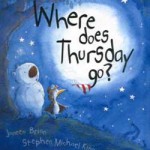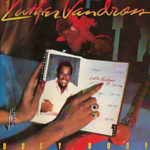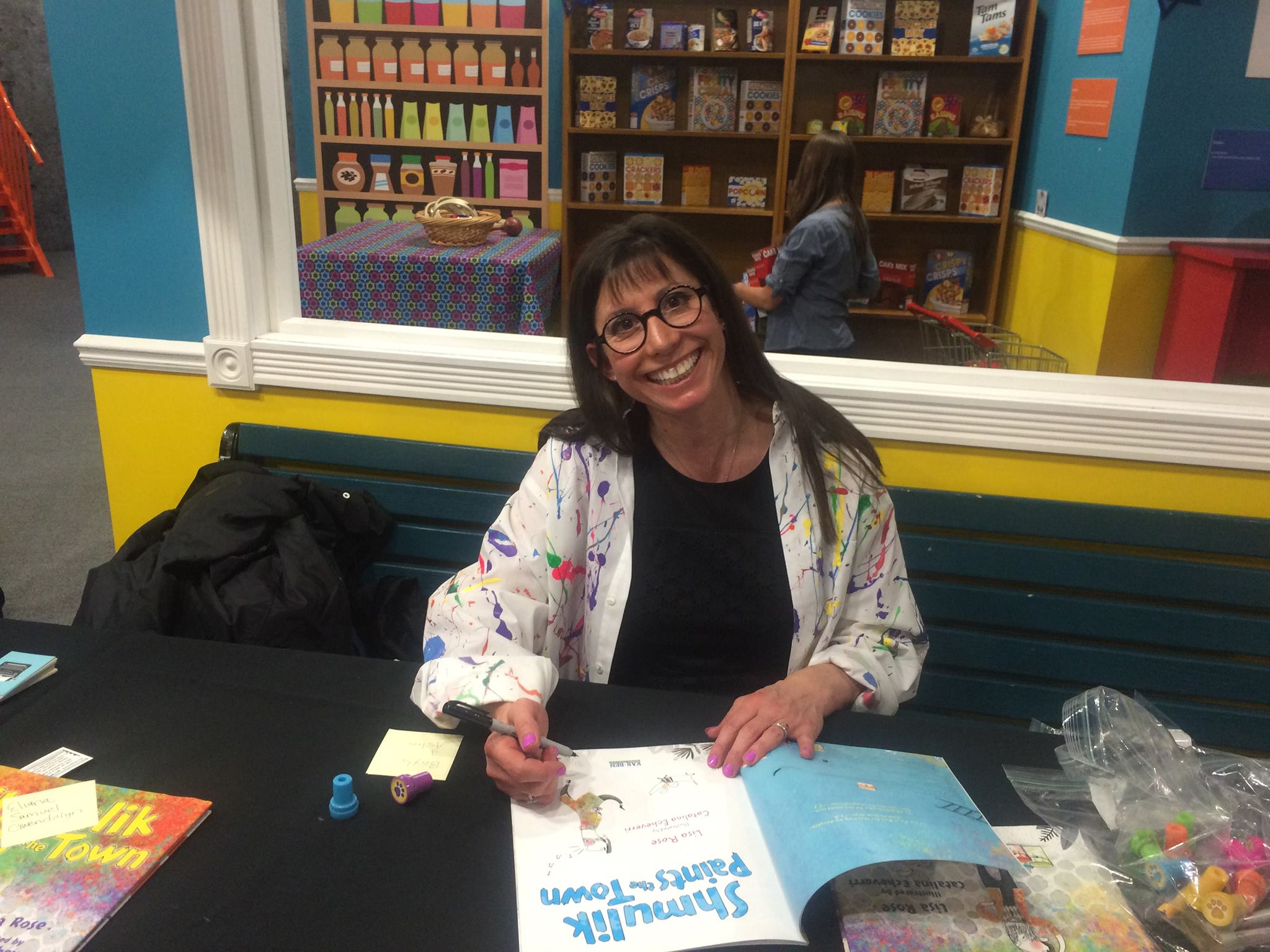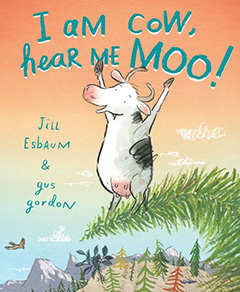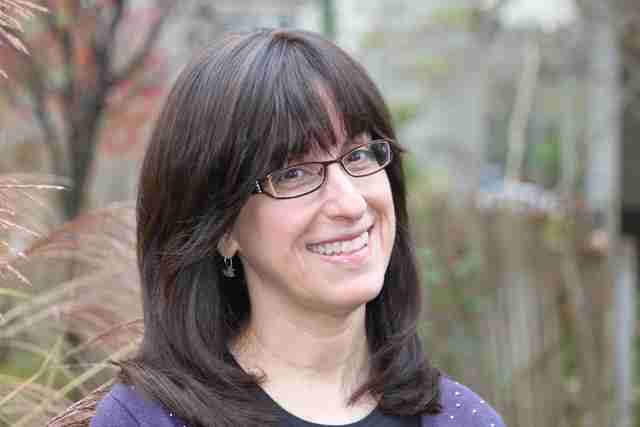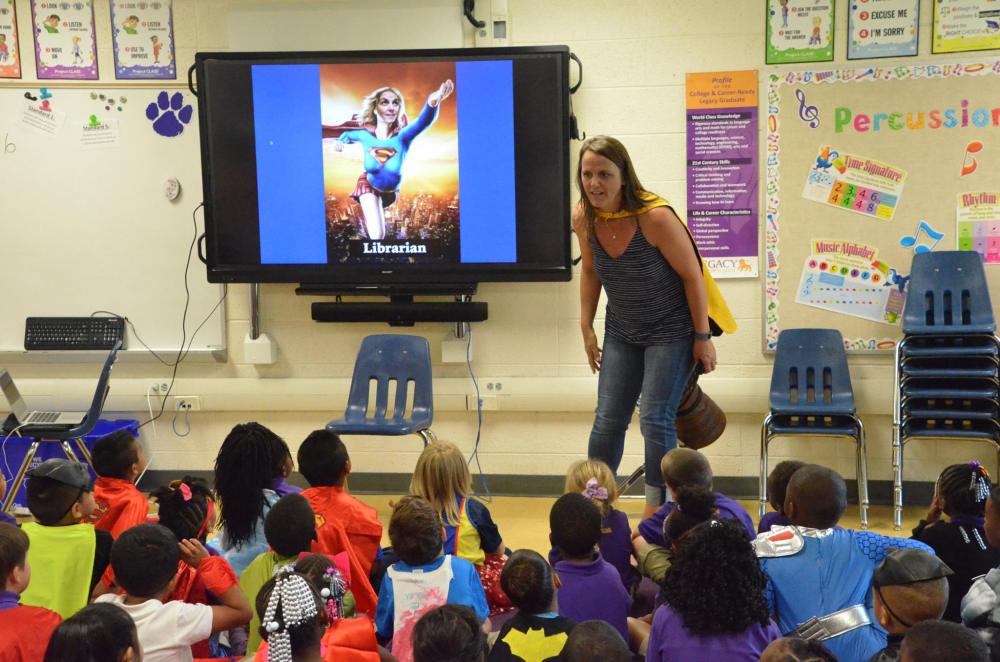 Kristy Dempsey is an amazing author. She’s prolific and creates books children love reading. They also love visiting with Kristy in person as she gives some of the best presentations ever…and all over the world too. She’s the author of seven books, including A Dance Like Starlight, Surfer Chick and Superhero Instruction Manual among others and she has a really cool sounding book coming out in 2019. You can read about that one below…
Kristy Dempsey is an amazing author. She’s prolific and creates books children love reading. They also love visiting with Kristy in person as she gives some of the best presentations ever…and all over the world too. She’s the author of seven books, including A Dance Like Starlight, Surfer Chick and Superhero Instruction Manual among others and she has a really cool sounding book coming out in 2019. You can read about that one below…
Now, onto the interview!
Kristy, your books prove you have a great sense of humor so I want to start off this interview with a smile and sort of put you on the spot. Can you please share with our readers one of your favorite corny jokes?
Oh, gosh. So many things make me laugh. I think some of my favorite jokes are based on wordplay and puns, when words are used in an unexpected way or take advantage of double meaning and/or similar sound/pronunciation. But the jokes that cause me to belly laugh are the result of the clever intersection between wordplay and circumstance, or in other words, when someone makes a clever joke off the cuff. Those jokes are usually the “you had to be there” kind and don’t really seem funny when repeated. So, here are a couple of the corny kind of jokes that make me giggle:
Q: What makes a joke a dad joke?
A: When the punchline is apparent.
Q: How do you prepare for a vacation on the moon?
A: You just planet!
Well, onto a real interview question 🙂 I guess procrastination can be a good thing, because instead of interviewing you with only one book under your belt, you now are the author of six published picture books and you probably have more somewhere along the publishing pipeline. How does an author like yourself keep writing quality book after quality book?
Hooray for procrastination, because I am now the author of 8 picture books and another forthcoming from Dial! I think the key to writing quality picture books lies in three important guidelines:
1. Know your audience. My books range from stories for the very young to literary stories for older students. Be sure that the story you are writing will speak to the target audience.
2. Honor the page turn. In picture books, the page turn is king. It is what keeps a child reading. So be sure to include plenty of opportunities for the reader to WANT to keep reading.
3. Leave room for the illustrations. I’ve been privileged to work with some amazing illustrators. And our stories wouldn’t have been even half of what they are if the illustrators had not added their storytelling into the mix.
We have many aspiring picture book authors read the interviews on our site. One piece of advice they’ve seen from editors and agents for years is to stay away from writing books with rhyming text and I’ve also read numerous articles on the topic. Many of your books feature rhyming text, so what are your thoughts on the subject?
I love this question because I adore rhyming books immensely. And I still haven’t figured out what MAKES ME write a story in rhyme. It’s a feeling, more than anything. In recent years, I haven’t written as many books in rhyme as before. But that doesn’t mean I don’t think they are important! As a teacher at an international school, I work with many students who are learning to read in English. And rhyme can be an excellent tool that students use to help them predict. So it is absolutely important for students who are learning to read. It can also be enjoyable to read! The rhythm and rhyme give students a structure in which to fit their pronunciation.
BUT, rhyme and meter are very difficult to do flawlessly. It takes a lot of work. You must be willing to revise, rethink and rework your stories many, many, many more times than you would have to in prose.
With A Dance Like Starlight and Superhero Instruction Manual, you added traditional non-rhyming picture books to your repertoire. Which type of picture book do you believe is more difficult to write?
When I am trying to write a book, all books are hard! Re-“seeing” a manuscript is incredibly difficult and I must reread it, aloud, a thousand times. I am now an English teacher but I was a librarian for 8 years and I read thousands of books aloud. It taught me to read my own books out loud as if I were reading them to students. I more easily see and hear my mistakes when I read aloud. So, neither rhyme, nor prose, is more difficult. The difficult thing is being patient enough to take the time to make the story what it must be to speak to the reader.
Would you say there’s a typical timeline for the creation of a picture book text? Is it days, weeks, years?
Oh, dear. My quickest picture book took 30 minutes, I kid you not. My longest has taken 11 years. My typical, or average, might be a couple of years?
It’s been years since you sold your first picture book. How has the book market changed over the years and what do you do differently now than you did in the past i.e. marketing and self-promotion?
This is a loaded question. I do think authors are expected to be ever more engaged in social media and blogging and maintaining a website and interacting with teachers, and on and on and on. These are all good and important (and invigorating!) things. And yet, for authors like me who teach or work full-time, there is a limit to our capacity. I try to keep in mind something that I’ve heard Katherine Paterson say, (I’m paraphrasing): “The very ones I thought would take time from my writing are the ones who have given me something to say.” So I value my time as a teacher most of all, because it has given me interaction with students and continually keeps me in the mix of what they want and need to hear. Beyond that, I *try* to stay involved in social media and in scheduling appearances. But there is a limit to what I am capable of, and I trust that my engagement with my students will connect me in ways beyond what I might be able to do through other self-promotion.
One visit to your author website, “visit” being the key word here, and one can see you must really enjoy school visits 🙂 So many pictures. So many schools. And those schools are on three continents (South America, North America and Asia. How do you get to speak in so many places?
I adore school visits! This is the type of self-promotion i love because it is all about promoting the student readers with whom I come in contact. What a privilege to be able to visit readers around the world and interact with them over their favorite books, favorite stories, favorite themes, favorite authors. Because I am a teacher at an international school, I’ve had the opportunity to promote my work to other schools around the world and have received invitations to speak to students in many different places. I always come away energized and enthused about how the kids of the world are going to change the world.
I read on your website about ministry work in Brazil. Is your work at the school associated with a ministry? If so, can you tell us more about the work? Ministry work in Brazil sounds fun and rewarding.
Nineteen years ago, in 1998, my husband and I were working for a Christian ministry in the US that was an outreach to college students. We were invited to join a team that would move to Brazil to work with this same ministry. At the time, we were up for adventure and felt a solemn sense of responsibility to give back out of the incredible education and heritage we’d been given. We thought at the time that we might live in Brazil 3-5 years. We’ve now been here 19 years, engaged in a more satisfying, life-changing work than we could have ever imagined.
My writing career began here in Brazil, in 2004, when I began writing for children and imagining what it might be like to be published. As my children grew, and their English educational needs grew, I sought out a job at the American School of Belo Horizonte, an International Baccalaureate school that has provided my own children with an education that has fostered a love for learning and given them a desire to use their knowledge for global change. Our school is a secular school, but the vision of service and global impact of the school has inspired my own children to think about their own contributions to the world.
Going back to school visits for a moment, what’s the funniest or wackiest thing that you’ve ever encountered at one?
Oh, so many things. The young boy who mentioned that the most difficult and scary thing he ever experienced was being chased by dinosaurs. The student who asked me to sing “Despacito”. And of course, students who ask me to sign books that I didn’t write. But I love each interaction. I’ve had some really sweet moments, too, that bring tears to my eyes, like the young girl who told me that A Dance Like Starlight was the first book she’d ever loved. Talk about tears! I almost couldn’t finish the day.
When you were a young student, did any authors ever visit your school?
When I was a student at Duncan Chapel Elementary, an author came to our school to talk about her books. I remember where I was sitting in the library. I remember our librarian introducing her and telling us how special this day was. But I do not remember her name. I do remember, though, how much she made me want to read, not just her books, but ALL the books. It reminds me of the Maya Angelou quote, “I’ve learned that people will forget what you said, people will forget what you did, but people will never forget how you made them feel.”
Can you take us back to your early childhood and describe how picture books were used in your life? Was reading a bedtime ritual like it was in my house or do you have other memories of picture books as a child?
Reading was definitely a bedtime ritual. I read almost every night, whether a book or a magazine or a Reader’s Digest! Each summer, my parents would actually pay me to read, not because I needed the incentive, but because it was a way for me to earn extra “allowance”. I got a dime for each picture book and a quarter for each chapter book!
What were some of your favorites?
As a young child, I loved Flicka, Ricka and Dicka, an import about triplets. I secretly wanted to be a twin or a triplet so we could play tricks on people! Later, I adored Anne of Green Gables and her wonderful imagination. Oh, how can we survive without imagination? Books are emotional rehearsal for new life experiences. Books allow us the grace of imagination to prepare us for our own lives.
What gives you the most satisfaction as an author?
Two things: 1) when a parent tells me that my book gave them a moment of intimacy with their child, and 2) when a child tells me they see themselves within my book. There is no greater honor.
You stay quite busy as an English teacher but I assume you always find time to write. Can you tell us about any of your upcoming releases or any stories your’re working on at this time?
I do! I wake at 5 am every day. This is a big deal because I am not a morning person. But I have found that if I do not write in the morning, it will not happen. Sometimes I only get 20 minutes in. But that’s more than if I had not written. My forthcoming books include a book about factory workers who contributed to the moon landing in 1969. The book is currently called, PAPA PUT A MAN ON THE MOON, but that title might change! It will be published by Dial in 2019, just in time for the anniversary of the moon landing.
Finally, can you share with our readers something about yourself that they might be surprised to learn?
I went to a fine arts high school for music and was trained in classical voice. Two of my colleagues went on to perform major roles on Broadway, another is an internationally recognized conductor, and yet another is a internationally recognized operatic star. I feel privileged to know them and to have learned alongside them. I still enjoy singing and I think there are a lot of creative connections between being willing to perform and being willing to submit your work to editors. It takes a lot of personal security and confidence. You never know what the response will be!
More Kristy Dempsey
Check out picture book author Kristy Dempsey’s Amazon Author Page
Check out picture book author Kristy Dempsey’s author website

